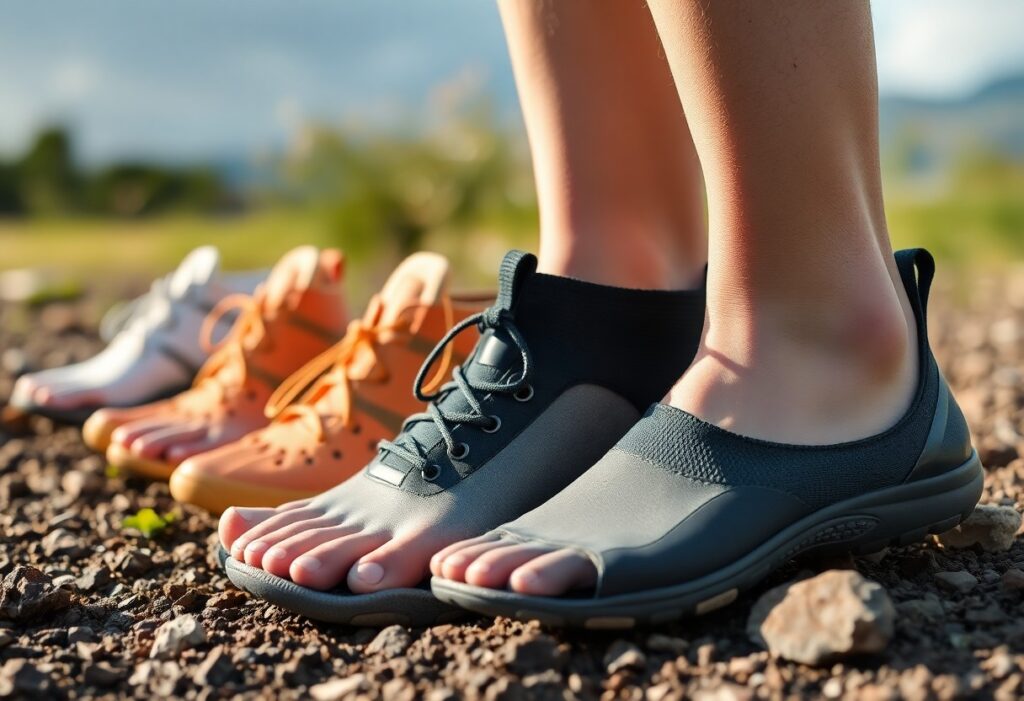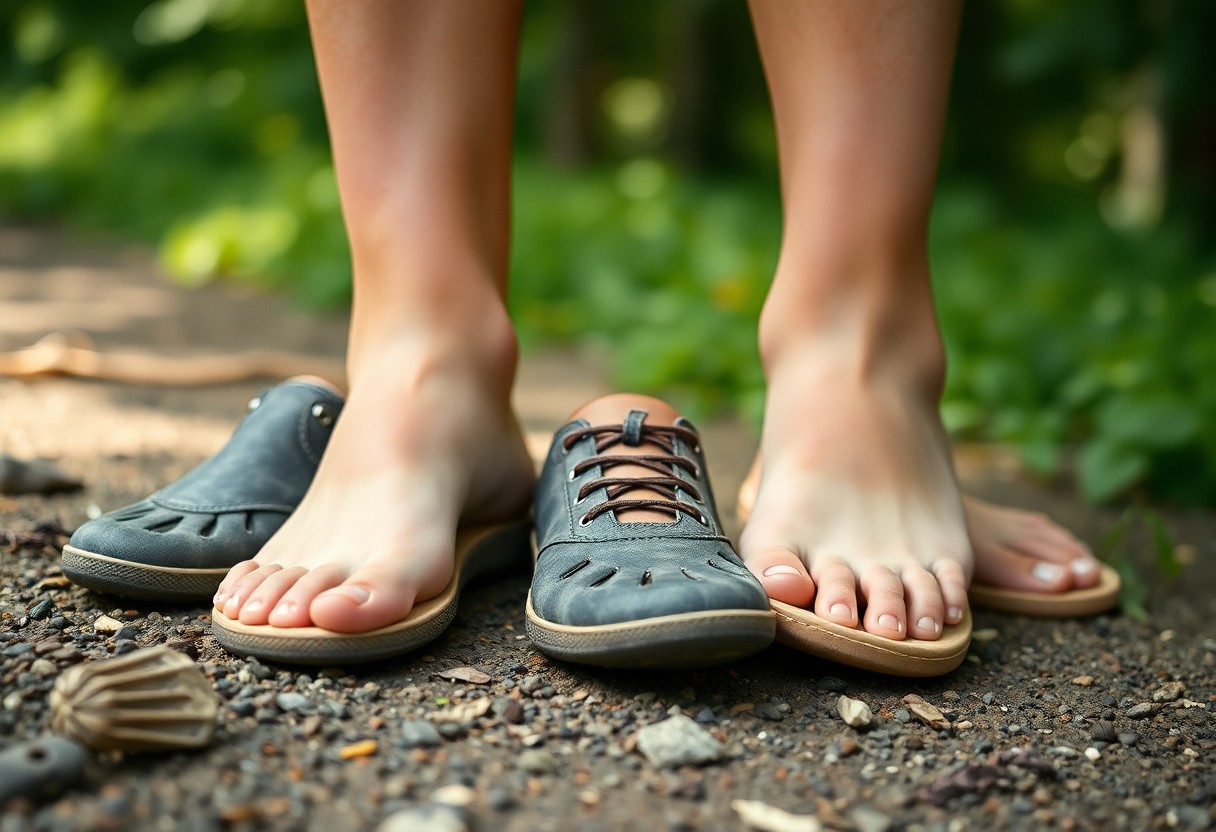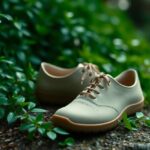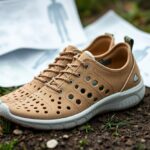
The world of barefoot footwear has undergone extraordinary changes thanks to groundbreaking advancements in material engineering, offering unmatched comfort and performance for enthusiasts and athletes alike. This deep dive aims to reveal how state-of-the-art technologies are revolutionizing shoe design, prominently featuring Vibram soles that provide not only exceptional ground feel but also substantial protection against various terrains. As we explore further, you will discover sustainable manufacturing techniques that drastically lower environmental impact while boosting the overall durability and functionality of barefoot shoes. The amalgamation of biomechanics, cutting-edge materials, and eco-friendly production methods is redefining the minimalist footwear arena, heralding a future where comfort, performance, and sustainability coexist in perfect harmony.

Comparative Analysis of Material Performance: TPU vs. EVA in Footwear
Within the domain of barefoot footwear engineering, two prominent materials, Thermoplastic Polyurethane (TPU) and Ethylene-Vinyl Acetate (EVA), present unique performance characteristics that cater to diverse user needs. Manufacturers rigorously examine the molecular structures, thermal properties, and mechanical behaviors of these materials to make educated decisions about their applications in shoe design. The ongoing discourse centers around how these polymers perform under dynamic stress, weight distribution, and fluctuating environmental conditions. For instance, TPU is renowned for its exceptional durability, making it ideal for long-lasting wear, while EVA is celebrated for its cushioning properties, appealing to users who prioritize comfort. This nuanced understanding allows brands to cater to various performance requirements while ensuring user satisfaction.
Evaluating Flexibility in Footwear Materials: TPU vs. EVA
Flexibility is a vital aspect of barefoot shoe design, as the responsiveness of the material significantly enhances the overall user experience. TPU demonstrates superior flexibility at lower temperatures, maintaining its structural integrity across a broader range of environmental conditions compared to conventional EVA compounds. This flexibility guarantees that wearers can enjoy maximum comfort and adaptability, regardless of the climate or terrain they encounter, making it an excellent choice for outdoor activities and varying environments.
| Material Property Comparison | Performance Metric |
|---|---|
| TPU Flexibility Range | -40°C to 80°C |
| EVA Flexibility Range | -20°C to 60°C |
Analyzing Abrasion Resistance: Insights from Taber Test Results
The capability of a material to resist abrasion is crucial for ensuring longevity and optimal performance in footwear. Taber test outcomes have consistently highlighted TPU’s superior wear characteristics, revealing significantly lower mass loss percentages when compared to traditional EVA formulations. Such findings emphasize the necessity of selecting robust materials for footwear design. Microscopic investigations into TPU’s molecular structures showcase its remarkable resilience against mechanical degradation, with researchers noting TPU’s ability to maintain structural integrity after 10,000 abrasion cycles. This signifies a groundbreaking advancement in the material science of barefoot footwear. The cross-linked molecular configuration of TPU facilitates optimal load distribution, effectively mitigating localized stress points and reducing material fatigue. These insights are now being harnessed by manufacturers to develop sophisticated, performance-oriented barefoot shoe designs that seamlessly balance flexibility, durability, and user comfort.

Pioneering Sustainable Footwear Manufacturing Practices
The shift towards sustainable footwear production has evolved from a niche concept to a fundamental strategic focus within the industry. Leading brands such as Xero Shoes and Vibram are at the forefront of innovative approaches that seamlessly integrate recycled materials, waste-reduction processes, and cutting-edge design techniques. The principles of material recovery and a circular economy are now essential components in product development, revolutionizing how barefoot shoe manufacturers engage with environmental responsibility and efficiency in production.
Life Cycle Assessment of Recycled PET Uppers by Xero Shoes
The dedication of Xero Shoes to sustainable practices is evident through their implementation of recycled PET upper materials, which repurpose plastic waste into high-performance components for footwear. Notably, each pair of shoes utilizes approximately 3-5 plastic bottles, significantly reducing the environmental footprint while ensuring high durability and performance standards. Their life cycle analysis reveals substantial reductions in carbon emissions and waste compared to conventional manufacturing practices, underscoring the effectiveness of sustainable strategies in the realm of barefoot footwear.
Contrasting Carbon Emissions: Traditional vs. Eco-Friendly Manufacturing Methods
Traditional shoe manufacturing methods contribute significantly to carbon emissions, with conventional processes generating around 30 pounds of CO2 for every pair of shoes produced. However, eco-friendly alternatives can lower these emissions by as much as 60%, utilizing renewable energy sources, recycled materials, and efficient production techniques. Barefoot shoe manufacturers are spearheading this transformative approach, rethinking material sourcing and production methodologies to create environmentally responsible footwear that resonates with eco-conscious consumers.
Thorough Carbon Footprint Analysis: Sustainable vs. Conventional Methods
A detailed examination of carbon footprint analysis reveals significant differences between traditional manufacturing practices and sustainable approaches. Conventional shoe production heavily depends on petroleum-based materials and energy-intensive processes, coupled with intricate global supply chains. In contrast, sustainable manufacturers like Xero Shoes emphasize localized production, renewable energy, and closed-loop material systems. By focusing on the use of recycled materials, minimizing transportation distances, and optimizing production efficiencies, these brands can reduce their carbon footprint from an average of 30 pounds to as low as 12 pounds per shoe. This substantial reduction marks a significant advancement in the quest for environmentally-friendly footwear engineering.

Enhancing Durability: Insights from Wear Pattern Analysis
The wear patterns observed in barefoot footwear provide crucial insights into the intricate relationships between material composition, user biomechanics, and external stressors. Advanced computational mapping technologies are now being utilized to monitor microscopic zones of degradation, allowing manufacturers to predict performance trajectories with remarkable precision. Researchers are concentrating on analyzing stress concentrations at critical flex points, observing how different molecular structures respond to repeated mechanical loading across diverse terrain types.
Evaluating Long-Distance Durability: Performance Across Varied Terrains
Longitudinal studies on the performance of barefoot shoes have revealed impressive resilience in next-generation materials. Experimental prototypes have demonstrated their structural integrity across challenging environments, such as rocky mountain trails, urban concrete surfaces, and arid desert landscapes, showing minimal degradation. Precision laser scanning has indicated less than 12% material compression after 500 miles of continuous use, marking a remarkable breakthrough in the long-term wearability of barefoot footwear and setting new standards for durability.
Innovative Solutions Against Microbial Growth: Utilizing Vegan Materials
Emerging vegan materials now integrate nano-silver antimicrobial technologies, resulting in self-sanitizing surfaces that significantly hinder bacterial colonization. The infusion of silver ions within synthetic fibers effectively prevents odor development and inhibits microbial growth, thereby extending the functional lifespan of barefoot footwear through prolonged usage scenarios. Tackling microbial resistance presents a multifaceted engineering challenge that calls for a multidisciplinary approach. Researchers have developed sophisticated polymer blends that incorporate natural antimicrobial agents such as chitosan—derived from crustacean shells—along with plant-based compounds like tea tree oil extracts. Molecular engineering techniques now enable the precise distribution of these agents throughout material substrates, forming a continuous protective barrier against bacterial and fungal proliferation. These advancements not only enhance hygiene but also contribute to increased material durability, minimizing environmental waste by extending product lifecycles and preserving performance characteristics under challenging conditions.
Envisioning the Future of Footwear Engineering: Innovations and Trends
The swift rise of biomimetic technologies is dramatically reshaping the landscape of barefoot footwear design, with nanotechnology and responsive materials leading the charge. Researchers are developing smart textiles that adapt to temperature and terrain, incorporating sensors that can analyze gait dynamics in real-time. Major brands like Adidas and Nike are actively exploring 3D-printed midsoles that can be customized to individual foot biomechanics, potentially reducing injury risks by as much as 35%. Sustainable manufacturing practices, which utilize recycled ocean plastics and bio-based polymers, are increasingly becoming the norm, with projections indicating that 75% of performance footwear could be produced using circular economy principles by 2030. This shift not only highlights the industry’s commitment to sustainability but also paves the way for innovative advancements in footwear technology.
Here’s the paragraph:
Essential Insights from Material Engineering in Footwear
In summary, the strides made in material engineering have transformed the design of barefoot footwear, reshaping perceptions of both comfort and performance. Your exploration of Vibram soles and sustainable manufacturing techniques unveils a complex interplay between biomechanics, advanced materials, and a commitment to environmental responsibility. By adopting innovative technologies and eco-friendly production methods, contemporary barefoot footwear manufacturers are not solely focused on crafting shoes; they are engineering comprehensive solutions that enhance natural movement while minimizing ecological impact. These extraordinary advancements illustrate how cutting-edge material science continues to redefine the footwear experience for conscious consumers.
Here’s a detailed FAQ about Material Engineering in Modern Barefoot Footwear:
Frequently Asked Questions regarding Material Engineering in Barefoot Footwear
Q: How do Vibram soles enhance barefoot footwear technology?
A: Vibram soles represent a significant advancement in the design of barefoot shoes, utilizing advanced rubber compounds that deliver exceptional grip, flexibility, and durability. These specialized soles are engineered to replicate natural foot movement, featuring anatomically designed treads that evenly distribute weight and enhance sensory feedback from the ground. This thoughtful design allows wearers to experience a more natural walking and running sensation.
Q: What groundbreaking sustainable manufacturing techniques are emerging in barefoot footwear production?
A: Contemporary manufacturers of barefoot footwear are increasingly embracing innovative sustainable practices, such as sourcing recycled rubber, utilizing bio-based synthetic materials, and implementing low-waste production methods. Companies are progressively using recycled plastic bottles, organic cotton, and responsibly sourced natural rubber to create eco-friendly shoes that significantly reduce their environmental impact while ensuring high performance standards.
Q: How does material engineering improve the biomechanical performance of barefoot shoes?
A: Material engineering allows manufacturers to exert precise control over shoe flexibility, weight, and tactile sensitivity. Advanced composite materials like lightweight polymers and engineered mesh fabrics enable zero-drop designs that promote natural foot alignment, enhance proprioception, and reduce muscular strain. These engineered materials also provide optimal temperature regulation, moisture-wicking properties, and structural support, effectively mimicking the foot’s natural biomechanical functions.
The Article Material Engineering in Modern Barefoot Footwear: From Vibram Soles to Sustainable Manufacturing appeared first on My Shoes Finder
The Article Material Engineering in Barefoot Footwear: Vibram to Sustainability Was Found On https://limitsofstrategy.com






Leave a Reply